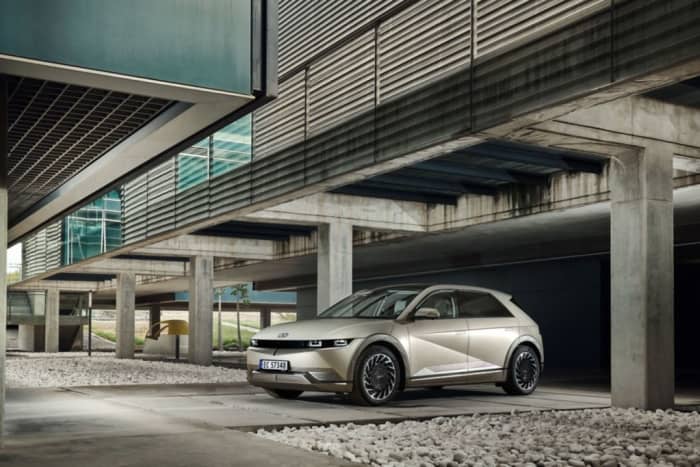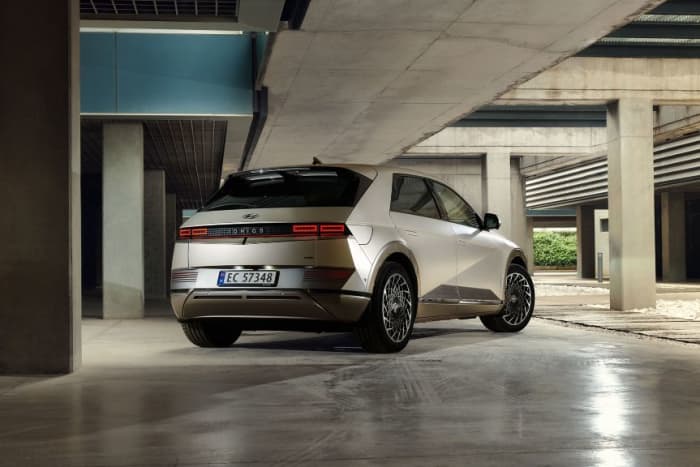This post was originally published on this site
Pros
- Arguably stunning looks
- Fast-charging ability
- Sustainable cabin materials
- Zero-emissions driving
Cons
Range is still not at Tesla
TSLA,
levels.
What’s new?
- The Ioniq 5 is a completely new vehicle
- Comes with 800-volt fast-charging capability
- Offers latest Highway Driving Assist 2 feature
Price: We expect the 2022 Hyundai
HYMTF,
Ioniq 5 to start in the region of $44,000.
The 2022 Hyundai Ioniq 5 is an all-new, all-electric vehicle. It goes on sale in the U.S. in the fall of 2021. After a trickle of electric vehicles — like the Nissan
NSANY,
Leaf, Chevrolet Bolt EV, and Tesla models — there’s not exactly a torrent, but an increasing number are hitting the market. Like the Volkswagen
VWAGY,
ID.4 and the Ford
F,
Mustang Mach-E.

The 2022 Hyundai Ioniq 5
Hyundai
This new electric vehicle (EV) from Hyundai is a compact SUV built on its own specific platform, with a lot of interior space. And an exterior that is not only a departure from Hyundai’s already interesting design approach, but could signal the creation of another brand, like Genesis has done in the luxury class.
It looks and feels like it’s pushing the EV envelope by another step or two with innovations like an augmented-reality head-up display and the ability to recharge other pieces of electrical equipment. The new Ioniq 5 also has seriously fast battery charging technology, taking on about 60 miles of range in five minutes, or charge from 10% to 80% in 18 minutes.
This is achieved by an 800-volt charging capability, like the Porsche
POAHY,
Taycan. More superfast chargers are being installed across the country, so the Ioniq 5’s technology does have practical benefits, not just impressive hypothetical numbers. And the Ioniq is compatible with 400-volt charging stations, as well as 240-volt (AC Level 2).
2022 Hyundai Ioniq 5 pricing
Looking at prices of the Hyundai Kona Electric subcompact crossover — as well as those of the Ford Mustang Mach-E, Volkswagen ID.4, and the Tesla Model Y — an educated guess for the 2022 Ioniq 5 would be a starting price of $45,000. We’ll know for certain closer to the autumn on-sale date.

The 2022 Hyundai Ioniq 5
Hyundai
Keep in mind that federal and state incentives could offset the initial outlay by about $10,000. Hyundai offers unlimited charging for the first two years, sweetening the deal even further.
Before buying, check the KBB.com Fair Purchase Price to find out what others in your area paid for their new Ioniq 5. The resale values of electric vehicles are quite strong, generally speaking.
At first, the 2022 Ioniq goes on sale in California, Connecticut, Maine, Maryland, Massachusetts, New Jersey, New York, Oregon, Rhode Island, and Vermont — the usual EV-friendly states. The company is also expanding Ioniq 5 sales into Arizona, Florida, Georgia, Illinois, North Carolina, Pennsylvania, and Texas.
See: 15 electric cars (and trucks) to watch for in 2022
To bring more buyers into the EV fold, Hyundai is considering a subscription service, where monthly payments include insurance as well. And a pre-reservation program has been established. Hyundai covers its Kona Electric with a 10-year/100,000-mile warranty of the drivetrain and battery, so there’s every reason to expect the same with the Ioniq 5.
Driving the 2022 Hyundai Ioniq 5
Hyundai has announced two propulsion setups for the 2022 Ioniq 5. The basic setup is the Ioniq 5 RWD. It uses a single electric motor and a 77.4-kWh battery driving the rear wheels with 225 horsepower and 258 lb-ft of torque. Accelerating from standstill to 60 mph takes around 7.4 seconds.
Like the RWD model, the Ioniq 5 AWD employs a 77.4-kWh battery. However, the Ioniq 5 AWD uses all-wheel drive that’s enabled by a second motor. This brings total output to 320 horsepower and 446 lb-ft of torque for a that’s-more-like-it time of 5.2 seconds to 60 mph. All variants have a top speed of 115 mph.

The 2022 Hyundai Ioniq 5
Hyundai
We’ve just mentioned range. Until the Environmental Protection Agency (EPA) calculates its own estimates, we’re going with Hyundai’s figures. For the Ioniq 5 RWD, the company targets a range of around 300 miles from a full charge. Chances are the EPA may be less optimistic, perhaps about 275 miles. That would be slightly better than the VW ID.4 and similar to the Mustang Mach-E. For the Ioniq 5 AWD, Hyundai’s range estimate goes down to 269 miles.
Interior comfort
A wheelbase (the distance between the front and rear axles) of 118 inches (4 inches longer than Hyundai’s 3-row Palisade SUV/crossover) has given the company plenty of scope to maximize interior space. It seems even bigger than it is, thanks to a roof made almost entirely of glass.
The dashboard has a suitably high-tech look, with dual 12.3-inch displays — one for driver information, the other for the infotainment system. The Ioniq 5 also offers a head-up display with augmented reality (AR) that can take up most of the windshield.
Sustainable materials are used throughout the cabin, such as plant-based fabrics and recycled plastic bottles.
Also see: EVs are catching on—registrations were up 95% in early 2021
Hyundai also mixes in some flexibility. A center console — called a Universal Island — slides forward and back with 5.5 inches of travel. It allows both front occupants to leave by the same door if necessary and provides rear passengers better access to the console’s USB ports and wireless charging pad.
The backs of the front seats are 30 percent thinner than a regular car seat, resulting in more space for those sitting behind. And their seats can slide up to 5.5 inches for greater cargo space. Speaking of which, the luggage area starts at 27.2 cubic feet and expands to 56.2 behind the front seats. There’s also just under a cubic foot’s-worth of stowage beneath the hood.
Exterior styling
Based on a concept car (the Hyundai 45) shown at the 2019 Frankfurt Auto Show, the Ioniq 5 is one of those unusual instances where the production version stays pretty close to the original flight of design fancy. It has conventional side mirrors instead of rear-facing cameras, but that’s more than forgivable.
It’s also rare in that the Ioniq 5’s overall look is clean, yet still interesting. It was inspired by the styling of the Pony, Hyundai’s first mass-market production car. The minimalist yet distinct bodywork (note the angular character lines on the sides) is contrasted by a more detailed Parametric Pixel design for the 20-inch alloy wheels.
The Ioniq 5’s exterior lighting continues that theme, with pixel-style lights evoking a 1980s retro-cool look. A clamshell hood is deployed to minimize panel gaps and help attain optimal aerodynamics.
Learn more: Curious about EVs? Here are answers to common questions about electric cars
Buyers have a choice of nine exterior paint colors. Five of these are exclusive to the Ioniq 5 and, says Hyundai, are inspired by nature.
Favorite features
Front-seat leg supports
While the Ioniq 5’s battery is being replenished, drivers and front passengers can indulge in some downtime by reclining their seats and letting retractable leg supports take the weight of their calves.
Vehicle to load charging
With an accessory connector, Hyundai allows you to use the Ioniq 5 as a generator. If there’s at least 15 percent of battery power in the Ioniq 5, you can use it to recharge other things. Such as another electric car, laptop, electric scooter, etc.
Ultrafast charging
The 2022 Ioniq 5 is designed for use with 800-volt charging stations. It can go from a 10% charge up to 80 percent in a mere 18 minutes. However, it’s also compatible with a 400-volt charger, where the 10-80 charge time is still a swift 25 minutes.
Standard features
We’re expecting the 2022 Ioniq 5 RWD SE to come with power-adjustable front seats as standard. Those dual 12-inch displays are standard, as are 19-inch wheels. No doubt, Hyundai will also include Apple
AAPL,
CarPlay/Android Auto smartphone integration.
Also see: Review: Hyundai’s first pickup, the 2022 Santa Cruz
Hyundai’s latest Blue Link connected services bring remote start, vehicle-status notifications, remote profile management, and other functions. Among the standard driver assistance features are forward-collision avoidance with automatic emergency braking, blind-spot monitoring with rear cross-traffic alert, Safe Exit Assist, and automatic high beams.
Factory options
All-wheel drive is available with all three 2022 Ioniq 5 trim levels. Highway Drive Assist 2 (see our Safety section), simulated leather seating surfaces, automatic flush-fitting door handles, ambient interior lighting, and hands-free tailgate operation are standard in the mid-level SEL.
Don’t miss: Onyx, nightfall, midnight—call it what you want, black is the new black in cars
The top-of-the-line Limited brings the AR-enhanced head-up display and the center console that can slide back and forth 5.5 inches. This trim level also has the Vision glass sunroof, plus surround-view and blind-view monitors, Remote Smart Parking Assist, and a Bose audio system.
We’d like to see an EV-specific navigation system giving the locations of chargers along the route. There’s a chance Hyundai may offer a solar-paneled roof, which can add charge to the battery while on the move. In sunnier climates, Hyundai says this might be good for roughly 1,240 miles a year.
Battery power, charge times, and range
The Ioniq 5 RWD uses a 77.4-kWh (kilowatt-hour) nickel-cobalt-manganese battery to energize a 168-kW electric motor turning the rear axle. The Ioniq 5 AWD uses that same battery and motor setup, but adds a 74-kW front motor.
Permanent-magnet synchronous reluctance motor (RWD)
58-kWh battery
167.6 horsepower
258 lb-ft of torque
EPA city/highway fuel economy: N/A
EPA-estimated range per full charge: N/A
Permanent-magnet synchronous reluctance motor (RWD)
77.4-kWh battery
225 horsepower
258 lb-ft of torque
EPA city/highway fuel economy: N/A
EPA-estimated range per full charge: 300 miles (manufacturer estimate)
Two permanent-magnet synchronous reluctance motors (AWD)
77.4-kWh battery
320 horsepower
446 lb-ft of torque
EPA city/highway fuel economy: N/A
EPA-estimated range per full charge: 269 miles (manufacturer estimate)
This story originally ran on KBB.com.


